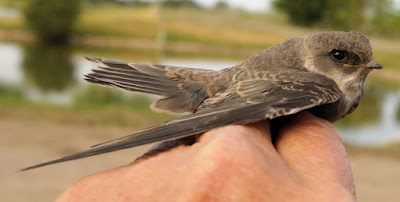Monday evening saw thunder and lightning rolling around the area followed by late night downpours. But we stuck to the pencilled in plan and hoped everything would be on song for Tuesday 0630, a visit to the Sand Martin colony at Cockerham.
Tuesday morning began fine, the rain and thunder long gone to leave a cool, almost idyllic morning at the colony. The 0630 start had left the birds a couple of hours or more feeding time before we intruded upon their space.
Two previous visits of 17 April and 26 May saw a total of 32 captures, 17 females, 14 males and one indeterminate sex of the April visit.
This almost mid-June visit would almost certainly result in a catch containing a percentage of youngsters and thus, together with noting brood patch progress, assessing the breeding success of the colony so far.
The colony is concentrated in one small area of the quarry face and estimated to be 60/70 active holes, not huge by Sand Martin standards but the only Sand Martin colony for a good number of miles around and therefore a valuable and unique addition to local flora and fauna.
We caught 25 on this latest visit, 12 adults (9 male, 3 female), three of them recaptures from earlier in the year; and 13 juveniles of the year.
We sex Sand Martins and many other species by examination of their cloacal protuberance in the case of males, and for females by her brood patch (bare belly) progress. Males of some species develop a partial brood patch that is not as extensive as that of a female, a bare region of the undersides that at the peak of incubation lacks any feathering at all.
Almost all birds incubate their eggs: keeping them warm while the embryo develops into a chick. In order to transfer heat better from their body to the eggs, many birds develop brood patches (a.k.a. incubation patches). The bird loses feathers from the belly, and the bare skin becomes wrinkly and swollen with fluid. Brood patches are a good way to tell what breeding stage a bird is at, since usually the brood patch begins to develop during nest building, becomes very swollen with fluid during incubation, and then declines.
Juvenile Sand Martins that spend a couple of weeks in their nest tunnels often emerge carrying swollen and unsightly blood sucking hippoboscid ticks that have attached their body parts through feathers and into the birds’ skin. The one pictured below had six such ticks on its head.
Sand Martin
We can remove the insect with a careful grasp of the blood-filled tick using ringers' pliers and then a slow and gentle twist & pull action that releases the parasite.
A bonus came with the catch of a feisty second summer male Kestrel when it tried to snaffle a Sand Martin but didn't count upon a mist net across it's normal approach line. There was some evidence of predation of the colony by the amount and type of feathers on the ground immediately below the nest holes.
Kestrel
All in all a very successful morning. Back soon with more news and views from Another Bird Blog.
Linking today to Eileen's Saturday blog.






























.jpg)












